How to make a Moscow Mule
The fiber swam-viscous, milky, sexual-on the other side of the amber glass. I pressed my eye as closely as I dared. My heart felt precious little shame as I thought, “That must be what it looks like in the moment before human conception.”
It was a Friday night, and I had shoved the inverted bottle of ginger beer into the handle of my oven. It was the only place I could find to hold the bottle upside down while I hand-rolled and cut my limes. A lime pressed and rolled against a hard surface is easier to juice, but that really wasn’t the point. The sediment was the thing, and it was distracting me from the limes.
Not enough has been written about the subject of sediment distribution vis a vis cocktail excellence, but in the twilight of that Friday night I knew I was doing it right. I was a voyeur, a Tom, peeping though the glass at the silky ginger fiber. It loitered with purpose in the middle of the bottle.
I was preparing to make my second Moscow Mule of the night, and the only thing delaying my progress was shameless sensory arousal. I breathed slowly as the ginger made its erotic journey around its 12-ounce, lightly carbonated womb.
On March 26, 2012, I received an email from a friend. His nom de degenerate is Grange95, a pseudonym he uses to protect his identity in a world where drinking and gambling are common but preaching their gospels is sometimes a sackable offense. The subject line of the e-mail read: “The Definitive Moscow Mule Recipe.”
I knew the e-mail was coming. It was the fire to the delivery smoke that clouded my doorstep days earlier. The first box contained four copper mugs. The second was a case of ginger beer. I opened both and then stepped away, afraid that the ensuing alchemy would erupt before I had the opportunity to put on protective equipment.
The greeting of the email got right to business and avoided any pleasantries.
Grange (who had sent the boxes special delivery in advance of his email) wrote, “I trust your resourcefulness as an uber-faller and professional citrus-tosser will allow you to procure a supply of vodka and limes.”
(There’s a certain Inside Baseball code embedded in those words you might not be able to decipher if you haven’t been a longtime reader here. Suffice it to say, I know my cocktails having spent much of my college days in cocktail bars thanks to a succession of fake ids, and I can hit a small space with a smaller lime at 30 yards and do so in a condition that would be considered dangerous for most people. Or, put another way, I’m no rookie. Let’s leave it there.)
The e-mail also came with a warning: “Fourteen Mules make you think you can play piano in a fancy martini bar, even without having taken piano lessons. Fifteen Mules make you fall off piano benches. My personal recommendation is to stop somewhere in the 11-12 range.”
The first time my wife had two Moscow Mules in a row, she kicked me in the eye during a romantic moment.
We needed practice.
I let my right hand hang out the window. It surfed the air like a child’s fingers on a station wagon road trip. My friend Lori pulled into a dark parking lot off West Sahara. Herbs and Rye looked like a dive. It was my only free night in Las Vegas, and this was the only place I wanted to be.
When I find something I like, I evangelize. Shamelessly. In 1999, Yahoo unveiled its LAUNCHcast product, a precursor to today’s Pandora-style streaming radio. In 2005, I discovered ECCO shoes. When I fell in love with both, I spent hours convincing others to experiment with me and join my travels on a new road to enlightenment.
So, over the four months since Grange’s e-mail, I had experimented, shared, and evangelized to almost everyone I knew. It was such a simple cocktail, and yet so very refreshing. I felt everyone needed to know about it.
To make the drinkable portion of a Moscow Mule, you need vodka, ice, a lime, and ginger beer. To serve it, you need a copper cup. These are the essential elements, but they in no way begin to tell this story the way it needs to be told. Finding the essence and finding perfection are two different things. One can take months. The other can take a lifetime.
The search for the perfect Moscow Mule is an evangelistic road similar to my ECCO shoes quest, but on this one I often need a designated driver. So, after countless Moscow Mules with my wife/guinea pig, that DD on that night four months later was a friend named Lori. She’d scouted Herbs and Rye and spotted the elusive Mule in the wild.
A giant man with a Thor-like hammer stood on the other side of the bar. He stuffed ice into a canvas sack (I’d learn later it’s called a “Lewis Bag”), put it on the edge of his bar, and beat it with his giant wooden mallet. It was simultaneously violent, artful, and erotic. I’d never been so turned on by a sweating 300-pound man in a black vest.
Thor went to work in a way I had never seen. It was at once robotic and fluid, like a wax museum bartender animated into a performance artist. By the time Thor finished, I had in front of me what amounted to a Moscow Mule sno-cone made with Fever Tree Ginger Beer and garnished with a paper-thin piece of lime peel.
And it was wonderful. I had two.
While I drank, I perused the Herbs and Rye menu. It listed its offerings by era, starting with the pre-Prohibition years and working its way up to the 1960s. I let my finger slide down to the Moscow Mule description where the menu read: “Was a marketing ploy by John G. Martin of Heublein Inc. as East Coast distributor of food and spirits.”
It was dark in the bar, and I hoped my barmates didn’t see me blanche.
A marketing ploy?
I’d been led to the perfect dark off–Strip bar in Las Vegas to drink what I considered to be the world’s best cocktail. In a moment, the drink I’d come to think of as my signature cocktail was no more than a marketing ploy? I felt cheated and somehow wronged (and yet, still, very refreshed). Fortunately, the Mule and conversation had kicked in, and my lament lasted only as long as it took to order the second drink.
Thank heavens for deeper research. Later (after something called Corpse Reviver) I went deeper into the story of the Mule Marketing Ploy and discovered the phrase on the menu was not only ripped off from a web page, but also failed to tell the full and amazing story of the Moscow Mule.
John G. Martin worked for the same company that made A-1 Steak Sauce. During his time at the company, he came upon what he thought was a golden opportunity, the kind of once-in-a-lifetime lark at which people of my ilk would jump: he had the chance to buy the Smirnoff vodka distillery.
Think on that for a moment. You work for a company that makes steak sauce, a substance based entirely on mitigating the offense of a badly-cooked piece of meat, and you are presented with an opportunity to buy a Russian vodka distillery…a substance that can exist on its own in a shimmering, radiant pool of 80-proof perfection. It looked like kismet.
What you might not know, and what Martin failed to predict, is that Americans didn’t really like vodka in the post-Word War II era. It was a drink for the savage Russians. Nobody was buying what the A-1 vodka-hawker was selling. Hence, Martin’s vodka distillery purchase became known as Martin’s Folly.
Martin traveled the country. He ended up having dinner at the L.A. Sunset Strip’s famous Cock ‘n’ Bull, a place with a surplus of ginger beer (the owner had been brewing it, but failing miserably at selling it). In what could only be described as very refreshing serendipity, the restaurant’s owner had a friend who had inherited a copper factory.
You see where this is going, right? Three hustlers have a bunch of stuff they can’t sell and combine it to create one of the most refreshing cocktails ever made. It was like the chocolate and peanut butter people running into each other in the office hallway, but with a much better, much more intoxicating payoff.
That, friends, is how a man from a steak sauce company came to create the Moscow Mule.
Further research suggested to me that the tale might be a bit on the apocryphal side, but it’s no doubt close enough to convince a man well into his second Mule. Or to put a finer point on it…I believe it.
I sat on that Las Vegas barstool thinking of steak sauce and vodka, and just before I closed the Herbs and Rye menu, I couldn’t help but notice the place offered a 60-ounce ribeye. Old John Martin would’ve had a heyday in that joint.
Meanwhile, Lori, who had inspired, encouraged, and facilitated my trip to Herbs and Rye, ordered a Kentucky Mule-a bastard cocktail made with bourbon instead of vodka.
The big man behind the bar didn’t even deign to look in Lori’s eye when he said, “We don’t alter the classics.”
***
If you have come this far (a place I can promise you is nearing the halfway point of this tale) you might need some further enlightenment exactly what makes a Moscow Mule.
For that, let’s turn back to Grange’s definitive recipe. It’s reprinted here with his permission.
The Definitive Moscow Mule Recipe
Mis En Place:
Gather the following items, arrange in a semi-circle on a semi-clean, acid resistant counter top.
Assembly:
1) Fill each mug approx. 1/2 full of ice cubes.
2) Pour 3 oz. (2 shots) vodka over ice (NOTE: the daring and the drunk can just eyeball it at 1/3 full).
3) Squeeze juice of three or four lime wedges into vodka; drop in wedge if you require a “garnish” (PRO TIP: if you really like lime or have scurvy, add a fifth wedge; use four or five wedges if using smaller limes).
4) Top off mug with ginger beer.
5) Stir gently.
6) Drink.
7) Repeat (CAUTION: Stand up at your own risk. The Mule can kick.).
Makes approx. 12 beverages (counting can be difficult after three Moscow Mules).
Print that part out and keep it with you at all times. I’m not even half-kidding.
“There it is!” my wife said. Her finger stabbed at the bar menu so hard she almost put a hole through the page. She let loose a sound that was undeniably, shamelessly, “Woot woot!”
“Ryan said it would be there,” I said.
I had already seen the Moscow Mule in the wild, but I’d not yet spotted a feral Mule in my own habitat. A friend had tipped me that we might find one at a new bar in Greenville’s West End.
A blonde bartender–her shirt cut low, her hair pulled back–leaned in.
“Which drink?” she said.
“The Moscow Mule,” my wife said. Her giddiness mirrored mine.
“I thought that might be it,” the bartender said. Before long, I realized why. Within minutes of our Mules arriving, three women at the far end of the bar ordered a round for themselves. Ten minutes later, a man who couldn’t find a seat along the rail, stood behind us.
“I’ll have one of those Mules,” he said. Word was getting out.
Stacey Wingate arrived in Greenville, South Carolina in June of 1999. He’s lived in this city for almost exactly as long as I have. It’s home, and a place where he recently stepped into the position of bar manager at one of the newest restaurants in town, Breakwater. He’s the type of bar manager who memorizes his customers’ names and drinks. He creates cocktails and infuses vodka by the gallon. The night we arrived, he had cucumber-mint martinis and watermelon Manhattans.
Wingate makes his Mules with Russian Standard vodka, Goslings ginger beer, and cubed ice. Like any man I respect, he doesn’t like to serve a Mule outside of a copper cup. He keeps them high on a shelf over his cash register.
“People steal them,” he said. “They are not easy to get. People get a little more brave after a couple.” (Note: there is no piano to take over like Grange’s martini bar, so people have to do something when they get deep into a Mule ride.)
Wingate’s vodka distributor brings him a couple copper cups at a time, just enough to keep up with the lime-sticky fingers and their attachment to Breakwater’s vessels.
“I have my own copper cups,” I said, hoping to allay any of Wingate’s fears about me thieving one of his.
“It’s a good drink…” Wingate began before stopping to think. “Well, it’s a good drink any time, but it’s especially good in the summer time.”
And then he said the words that forever endeared me to him.
“It’s…refreshing,” he said.
On the night I shoved the bottle upside down into the oven handle, I recalled a conversation I’d had over the phone just a few hours earlier.
“You’re looking for a bottle with sediment,” I’d told my younger brother. And I meant it.
Finding ginger beer in the wild isn’t an easy task to begin with. You’re probably not going to find it in your local Safeway. Once you do find ginger beer, you still may be a long way from finding the best. I’ve sampled more than half a dozen ginger beers since this journey began six months ago. Before we get to what kind you should be picking, I need to reinforce a very important point.
If you’re going to travel the Mule road, you don’t want to take the first step without this knowledge: ginger ale and ginger beer are not brothers. They are barely cousins. Ginger ale is Pat Boone to ginger beer’s Little Richard. Mass-market ginger ale is the best-selling soda water flavored with ginger. Ginger beer is brewed-fermented!-with ginger. You’ll never see a bottle of Schweppes with milky ginger root sediment in the bottom. As Grange said, serving a Moscow Mule with ginger ale is like serving tofu and calling it steak. That stuff won’t fly in Herbs and Rye, I guarantee you that.
My brother had called from halfway across the country seeking advice on the best ginger beer for his new copper mugs. That’s when I started talking about sediment.
There are many ginger beers on the market. They’re all fine for making a Mule, but few have sediment, that viscous, fibrous floating ginger root that, to me, defines a Moscow Mule’s essence. I’ve found only two ginger beers that meet my full approval. The best is Fever Tree. If you can find it and afford it, make your Mules with nothing else. In lieu of that, I recommend the ginger beer made by The Ginger People brand (sometimes found at Whole Foods). I’m sure (I hope) there are others with the right amount of sediment, but I’ve not found them yet.
But that’s not entirely the point, either. The point was that my brother-with whom I speak over the phone only when it’s required that we articulate a point very clearly-had called to ask advice on the proper ginger beer to top his Mule. That, like the sediment, was the thing.
The day Grange introduced me to the Moscow Mule was the day I began sharing it with other people. Chief among those people was my wife. For reasons I can’t fully explain, the Moscow Mule gave us a new reason to sit outside, a reason to sit and watch the fireflies, and, at the risk of getting a little corny, a new romance (remember, she kicked me in the eye). I’ve never felt closer to my wife than I do today, and I’d be blaspheming the Mule if I didn’t give it some credit for that.
Even beyond my schoolboy romance with my wife, the Mule has become a thing among my friends. We’ve named a poker game after it. We’ve angled for which four people get to consume the next round (I only have four cups right now, and there will be none served in a glass). What’s more, friends all over North America have seen the chatter and bought their own copper mugs. This weekend I traveled to another city and brought my copper cups with me. When I got home yesterday I re-named my fantasy football team the Moscow Mules.
It’s ridiculous in the best possible way. I even have two dear friends who avoid alcohol. Both of them-at different times-have surprised me by asking for a sip…just to see what it was like.
There is no art without conflict, and in the case of my education in the art of the Moscow Mule, it came down to the ice.
Recall, when Grange sent me his recipe, this was his note on ice:
“Must be 2 cm per side, made from water drawn during a new moon from the Ogallala aquifer.”
He followed that quickly with this: “PRO TIP: Any ice from the closest freezer will work fine.”
That ambiguity set me on a path toward a bastardization of everything my mentor considered pure. Beginning in March 2012, I made my Moscow Mules with crushed ice. Today, I make my Moscow Mules with crushed ice. As far as Grange is concerned, I’m playing Kenny G. on a kazoo.
There is a chance he will comment here and explain himself fully, but if I can presume to assert his position, it’s this: crushed ice waters down a drink where cubed ice does not. It’s that simple.
I can’t disagree with him. I like to drink good single malt scotch, and I drink it neat. Not even a drop of water. When somebody has worked very hard to perfect a flavor of a liquor, I want to appreciate that flavor.
But I’m also a man who appreciates an aesthetic. In my head-no, in my heart-crushed ice represents refreshment. Cubed ice is structured, uncomfortable, and noisy.
And, so, it’s on this position that the student drifts away from the teacher. Yet, despite this, there is a mutual trust and respect that we maintain. After all, we’re not in this entirely for refreshment. It’s all part of a greater effort to fight the scourge known as scurvy. Thank goodness limes come four for a dollar.
People ask why, and I can only think of those bastards Bartles and Jaymes. If you’re not from America, or if you were born too late, you may not remember the ad campaign that supported a line of so-called wine coolers. From the time I was in fourth grade until the time I was a junior in high school, two old fake men sat on a porch and convinced America that the process of making a good drink was something that could be reduced to bringing home a four-pack of bottles. They capped it all off with what became the iconic, “and thank you for your support.”
So, yes, people ask why, and I think of those two old men and how disconnected we have become from everything we put in and on our bodies. I’m just as guilty as everyone else. We’re busy. We’re in a hurry. We’d rather do something other than take time to actually make a drink. Why waste five minutes mixing when you can open a bottle and pour?
For me, it’s the like chicken. I can buy a roasted bird just about anywhere, or I can spend a couple of hours roasting my own, making stock from the bones, and making chicken salad from the leftovers.
Or it’s like my dear friend who refuses to shave like most men. Instead, he creates foam with a badger-hair-bristled brush and applies the cream to his face before shaving. Like the chicken and me, it’s a matter of feeling an integral part of the things you do to and put in your body.
What might have started out as a marketing ploy became something bigger in the lives the people it’s touched over the past 60 years. Bartles and Jaymes made pre-mixed drinks part of our too-busy culture. It made turning a bottle cap the most involved you’ll ever be with your drink. But John Martin’s Mule marketing ploy is something else. The cocktail requires time to make. It requires a search for the perfect ginger beer. It requires a copper cup. It’s more than a drink. It’s an event. It’s a quest.
And, for me, it’s about a process. I like being involved. There is a certain comfort in making something for myself and others. It’s process of creating something better than the sum of its parts. It’s a matter of not just falling in love with a drink, but falling in love over and over again with the people with whom you share that drink. It’s something very simple that solves-even only temporarily-a lot of the complex problems a day can bring.
Also, it’s very, very refreshing.

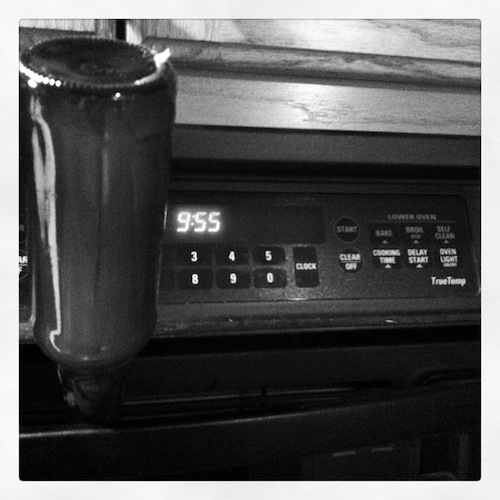
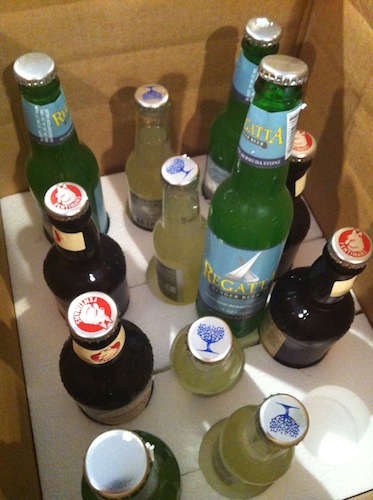

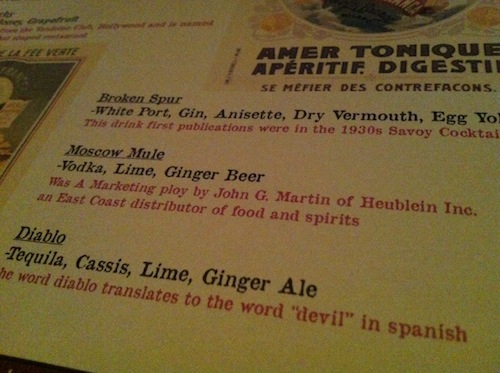
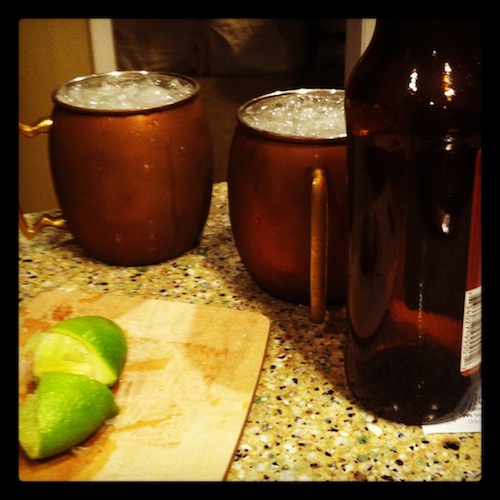
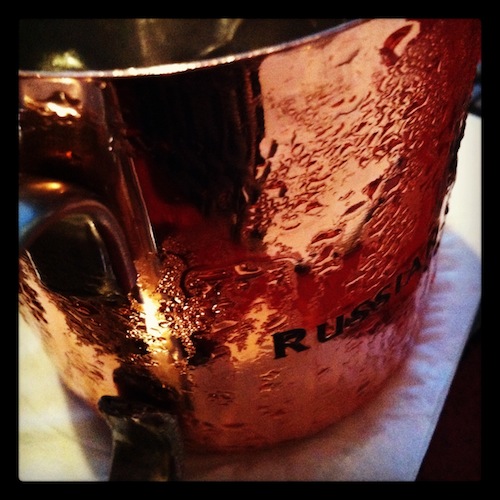
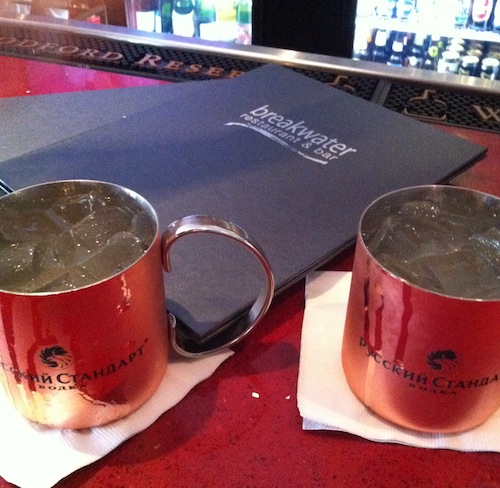
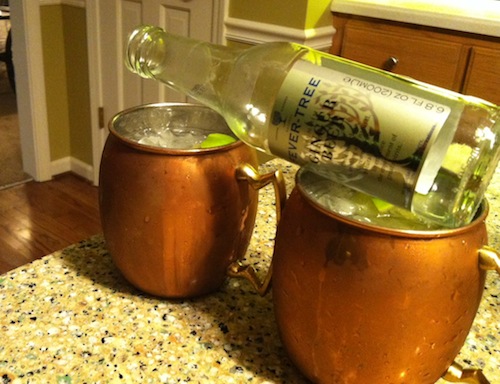
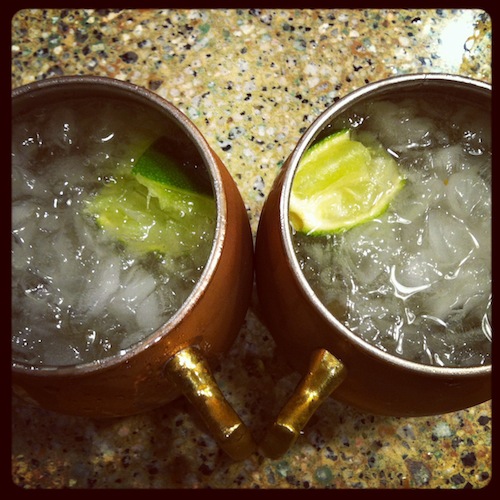
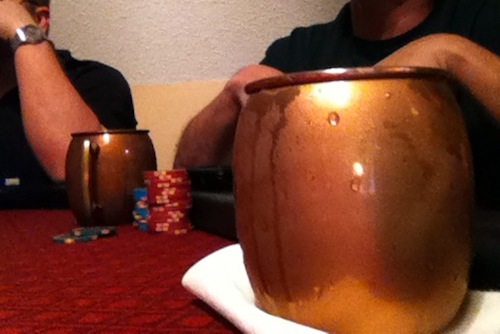


Shall I bring you some homemade gingerbeer?
Ron, that would be one heckuva gift. Well make some Mastodon Mules with it in late October.
The Rooster only uses Goya Ginger Beer for his mules. It gives it a bit more kick and spice. You know ladies, I’m Latin. Just saying. Bye.
Excellent write up as usual. I especially liked the terror element you introduced when you mentioned mint and simple syrup. I have used Fentimans and Barritts Sugar Free (I must some times do the needful to minimize the corporeal damage)Ginger Beer. For years I used Ginger ale and did not find any particular kick in the drink. I finally encountered Real Ginger Beer and I got; I REALLY got it! Still have not found it served in a copper cups anywhere in this area or NYC, perhaps I will make a purchase in that direction. I will keep an eye out for your recommended Ginger Beer as well. As to cubed versus crushed ice, it depends on the occasion. I find crushed ice gives me the most delight. Cubed on more formal occasions is acceptable. As to the addition of fluid, I do not sip my mule so there is often much ice left over. I do understand the concern though.
I had my first Moscow Mule some time in 2010 at a place called Stueben’s here in Denver. It became my most favorite cocktail. I prefer to make them at home since the bars like to charge upwards of $7 for one and some bars make you hand over your ID so that you won’t walk out the door with that copper mug. If you haven’t tried a Dark and Stormy (ginger beer, dark rum, and lime juice) it is a nice change once in awhile.
Hope to be able to share a Mule with you and the wife some time in the future!
Either Otis managed to escape the lockup or that mean old Brad left the key within reach of the broom handle. Welcome back, Otis.
This weekend I learned of the Mamie Taylor, or the mother of the Mule. Created at the turn of the century (predating the Mule by nearly 50 years) and named after the famous singer, it is precisely the Mule recipe… except with scotch instead of vodka.
Interesting piece of trivia – vodka was first marketed as “white whisky”, so the Mule is an easy jump from scotch whisky to white whisky.
It is also tasty, although I’d suggest it’s more of an autumn drink, what with the scotch in place of the vodka. Don’t worry, I used Johnnie Walker Black, I wouldn’t dare pour one of my good single malts in anything other than a proper whisky glass.
Tonight I plan on assembling ginger, sugar, water, and lime into a ginger syrup to be added at whim to carbonated water so I can control ginger strength to my liking and mood. I may explore fermentation down the road, but that will likely be unnecessary.
And FWIW, I started with the Fentimans, and found it lacking. Fever Tree is the clear winner, although I may try the Ginger People if my home recipe fails to excite.
Warren Haynes would be proud…
http://www.youtube.com/watch?v=_RRGV3hwick
A number of items:
I) I’m proud that, out of the ginger beer variety pack, you correctly identified Fever Tree as the ne plus ultra of ginger beers. The Mule is strong in you.
B) Crushed ice? Mene mule tekel upharsin. However, you are a true free-spirit, a citrus artiste. You have mastered the Platonic (and apparently the Erotic!) Mule, so perhaps I’m being overly dogmatic.
3) No, actually I want you damn kids off my lawn and take your crushed ice and Boone’s Farm with you!
Δ) OK, perhaps the crushed ice is acceptable. After all, the young grasshopper must eventually leave the nest and go West in search of cocktails, dreams, and DJ Metaphor.
e) I shall look forward to sampling a Mastodon Mule, the official name for the crushed ice Mule.
iv) As always, your writing is very refreshing.
Sitting here reading this while drinking a mule made with inferior ginger beer. Using the Grange95 recipe makes it at least a passible drink.
So, I did a quick search and low and behold, you can get cases of Fever Tree ginger beer on Amazon with Prime shipping! http://amzn.to/QpIWAx My first case will arrive on Thursday.
I wish you would submit this piece to the New Yorker. I’m a long time subscriber and this fits so well with what they do.
Thanks, Dee Dee. That’s flattering. Maybe some day I’ll make the bigs. Appreciate you reading. –Brad
I’m late to the party, but I have to comment on this. Crushed ice is used to rapidly cool warm or room temperature drinks. Cubed ice is used to keep cold drinks cold. Simple science.
Thanks for introducing me to the Mule!
Ummm, just came to my attention there was a typo in my recipe. Mugs should be 16 oz. Well, the mugs can be whatever size you want, but smaller mugs make for Mules with a bigger kick.